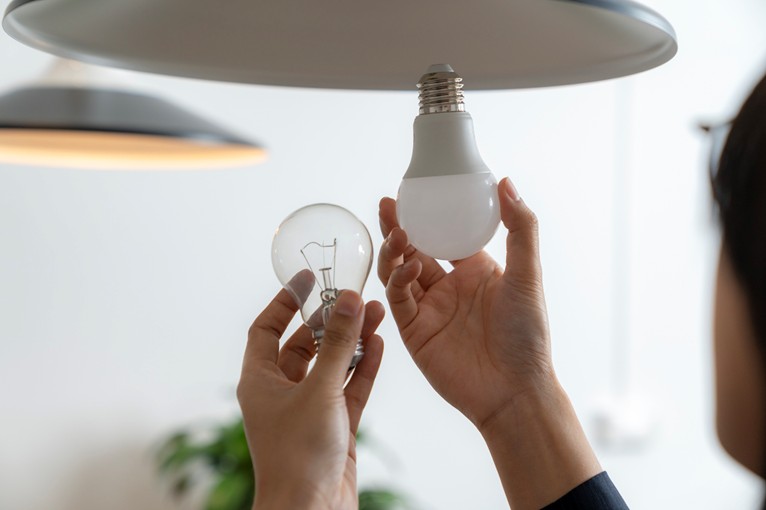Reader, We're living in a much brighter world than we used to. And that's bad news for your health.
LEDs, or light-emitting diodes, are everywhere now. They've almost completely replaced the incandescent bulbs that used to light our spaces.  Health-Damaging Effects
of LED Lights - Sleep deprivation
- Retinal damage in the eyes
- Type 2 diabetes
- Depression
- Cognitive function
- Heart disease
- Obesity
- Certain kinds of cancer
| On the surface, they look like an improvement. They're much more energy efficient. They last a lot longer. They're less likely to break unexpectedly.
But these bulbs have a dark side…
A few years ago, researchers published a lengthy report warning about the long-term health effects of LEDs.
The 424-page report, which analyzed over 600 studies, detailed the alarming effect LED bulbs have on "biological rhythms" – including our circadian rhythm, or sleep-wake cycle.
As you may know, the circadian rhythm regulates when you sleep – and when you use energy.
You see, sleep deprivation doesn't just affect how much energy you'll have the next day. It impacts your system at the cellular level.
A few years ago, a study on sleep-deprived rats revealed that removing REM sleep impairs the body's ability to make more mitochondria – the "batteries" your cells depend on.1
In the past, your body received the signals it needed from the sun. When the sun went down, and our exposure to blue light dissipated, our bodies knew to produce more melatonin – signaling that it was time to shut down. But with LEDs lighting just about everything, the body no longer receives the same signals.2
But that isn't all they found.
Researchers also found that LED lighting has a "toxic" effect on the eye, which wear away eyesight over time.
To understand the full impact this has on your health, it's helpful to know what sets LEDs apart from other lights. How Do LEDs Work? LED lights aren't like the lightbulbs of yesterday.
These light emitting diodes work by passing an electrical current through a semiconductor material. When power is applied, electrons in atoms move apart and recombine to create light in the form of photons. The semiconductor used determines the color of the light produces.
Gallium nitride, for example, produces blue light.
This is very different from other forms of lighting. Incandescent bulbs, which have effectively been eliminated from the market, produce light by heating a filament. LEDs convert electrical energy to light with minimal heating.
As I mentioned earlier, LED lighting is everywhere in the modern world. Almost every electronic device, such as smartphones, tablets, computer screens, and modern television screens use LED lighting.
Other sources include: - Indoor lights
- Car headlines and taillights
- Smartwatches and wearable devices
- Home appliances such as microwaves and refrigerators
- Billboards and digital signs
- Streetlights
- Retail and commercial lighting
Reduce Your Exposure To Blue Light With LED exposure almost impossible to cut off entirely, here are a few ways to maintain a natural circadian rhythm right now. - Try Vitamin D Lamp Therapy: Vitamin D lamps are devices that emit UVB light, which can help your body make more vitamin D. If you live in an area where sunlight is hard to come by for months at a time, they can be pretty helpful. Studies show that UV light can promote positive moods and defend against seasonal affective disorder.3
When using, keep the lamp at eye level and at a safe distance, and use for about 20 to 30 minutes.
- Keep Your Bedroom As Dark As Possible: To minimize sleep disruption, you need to limit your exposure to blue light. This means powering off all screens and limiting using devices with LED displays to the daytime as much as possible. This might mean completely covering windows, disabling night lights, or even tucking a towel under the door to prevent light from pouring in.
A completely dark environment will make it easier to achieve deeper levels of sleep, supporting mitochondrial biogenesis, a healthy metabolism, and more energy during the day.
- Go Back To Incandescent Bulbs: Most incandescent bulbs are banned in the U.S. and Canada, but certain specialty bulbs are still permitted. This includes decorative, Edison-style bulbs. Incandescent bulbs produce warm, natural light – and very little blue light.
They'll require more frequent replacing, but they offer a full and balanced spectrum of visible light.
To Your Good Health, 
Al Sears, MD, CNS
References: - Kim S, et al. "REM-sleep deprivation induces mitochondrial biogenesis in the rat hippocampus." In Vivo. 2022;36(4):1726-1733.
- French National Agency for Food, Environmental and Occupational Health & Safety. "Effects of systems using LEDs on human health and the environment." 2019. www.anses.fr/fr/system/files/PRES2019DPA01EN.pdf Accessed on March 12, 2025.
- Veleva B, et al. "Effect of ultraviolet light on mood, depressive disorders and wellbeing." Photodermatol Photoimmunol Photomed. 2018;34(5):288-297.
|
No comments:
Post a Comment